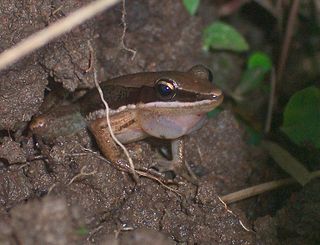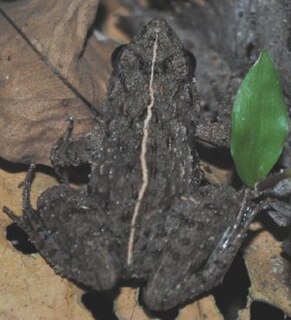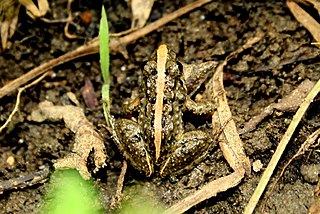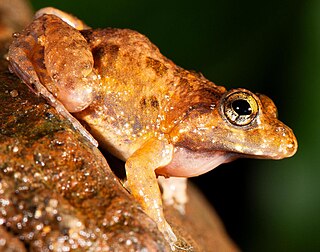
Fejervarya is a genera of frogs in the family Dicroglossidae found in Asia. First proposed in 1915 by István József Bolkay, a Hungarian naturalist, the genus did not see widespread adoption at first. As late as the 1990s it was generally included in Rana, but more recent studies have confirmed its distinctness.

The banded bullfrog is a species of frog in the narrow-mouthed frog family Microhylidae. Native to Southeast Asia, it is also known as the Asian painted frog, digging frog, Malaysian bullfrog, common Asian frog, and painted balloon frog. In the pet trade, it is sometimes called the chubby frog. Adults measure 5.4 to 7.5 cm and have a dark brown back with stripes that vary from copper-brown to salmon pink.

Leptobrachium smithi is a species of frog found in Southeast Asia. Its specific name honours Malcolm Arthur Smith, one of the early herpetologists to study the amphibians of Thailand.

Minervarya nicobariensis, the Nicobar frog or Nicobar cricket-frog, is a species of frog endemic to the Nicobar Islands of India. In the past it has been considered to be the same species as Fejervarya andamanensis from the neighbouring Andaman Islands, but is now regarded a valid species. It is restricted to the central and northern group of Nicobar Islands. It is relatively common in suitable habitat, particularly on Car Nicobar island. Its preferred habitat are grasslands, where the species breeds in the rainwater puddles. On Car Nicobar, it also occurs coastal wetlands and along newly cleared forest trails.

Zakerana nepalensis is a small-sized frog native to northern and northeastern India, Bangladesh, and Nepal. It has recently been reported also from Bhutan. Having distinct and narrow middorsal line (MDL); indistinct skin fringe on outer side of 5th toe; relative finger length (RFL) is 2<1<4<3, 1st finger scarcely longer than 2nd; laterally dark and medially pale throat in males; body tubercles oblong, arranged in longitudinal folds; and snout jutting over jaw.
Plectrohyla avia, also known as the greater spikethumb frog, is a species of frog in the family Hylidae. It occurs in Guatemala and Mexico and is found on the Pacific slopes of the Sierra Madre between southeastern Chiapas (Mexico) and southwestern Guatemala.

Leptopelis macrotis, sometimes called the big-eyed forest tree frog, is a species of frog in the family Arthroleptidae. It is found in the rainforests of Sierra Leone, southern Guinea, Liberia, Ivory Coast, and southern Ghana. Notice that similar common name "big-eyed tree frog" is sometimes used for Leptopelis vermiculatus from Tanzania and for Litoria exophthalmia from New Guinea.

Zakerana pierrei is a species of frog in the family Dicroglossidae. It is found in Nepal, adjacent India, and eastern Bangladesh. It has recently been reported also from Bhutan. It is a common species associated with paddy fields.

Minervarya sahyadris, also known as the small cricket frog, is a species of frog in the family Dicroglossidae. It is endemic to central Western Ghats of India.

Minervarya is a genus of frogs in the family Dicroglossidae from south Asia, and Nepal and Bhutan. They are also known as cricket frogs or rice frogs.

Hylarana tytleri is a frog species in the family Ranidae. It is found in eastern and northeastern India, Bangladesh, and southern Nepal, and possibly at lower elevations in Bhutan. It was formerly placed in Rana, and included in the common green frog. It is probably a close relative of that species nonetheless, and thus placed in the revalidated genus Hylarana, of which H. erythraea is the type species. Common name Theobald's ranid frog has been coined for it, although common names for Indian frogs previously identified as Rana erythraea include yellow-striped frog, leaf frog, and leaping frog.

Raorchestes parvulus is a species of frog in the family Rhacophoridae. It is found from eastern Bangladesh east through Myanmar and Thailand to Cambodia, northern Vietnam, Laos, and Peninsular Malaysia. Its distribution might well extend into northeastern India and southern China. This species was first described by George Albert Boulenger based on seven specimens collected by Leonardo Fea from Karen Hills, Burma.
Fejervarya triora is a species of frogs belonging to the family Dicroglossidae. Its type locality is in Phu Chong-Na Yoi National Park, Ubon Ratchathani Province in the far east of Thailand. It is also known from Mukdahan National Park in Mukdahan Province, and also Pha Taem National Park, Ubon Ratchathani Province. So far, it is only known from eastern Thailand, although it is not unlikely that it occurs in adjacent Laos too. It has been found in a range of forested habitats.

Shivapuri Nagarjun National Park is the ninth national park in Nepal and was established in 2002. It is located in the country's mid-hills on the northern fringe of the Kathmandu Valley and named after Shivapuri Peak of 2,732 m (8,963 ft) altitude. It covers an area of 159 km2 (61 sq mi) in the districts of Kathmandu, Nuwakot and Sindhupalchowk, adjoining 23 Village Development Committees. In the west, the protected area extends to the Dhading District.
Oreobates ayacucho is a species of frogs in the family Strabomantidae. It is endemic to Peru and known from a few localities in the Ayacucho Region in the Peruvian Andes. The species is only known from 11 specimens.
Zakerana asmati is a species of frogs found in the Chittagong and Dhaka, Bangladesh. Its type locality is on the University of Chittagong campus. It was described by Mohammad Sajid Ali Howlader in 2011.

Minervarya nilagirica, commonly known as Nilgiris wart frog, or Nilgiris frog, is a species of frog that is endemic to India.

Minervarya agricola is a species of frog that is native to Indian subcontinent. Earlier identified as M. granosa and Zakerana syhadrensis due to large distribution, the species was classified as a separate species in 2019.

Minervarya pentali, or Pental's Minervaryan frog, is a species of frog in the fork-tongued frog family, Dicroglossidae. It is endemic to the Western Ghats in India.














